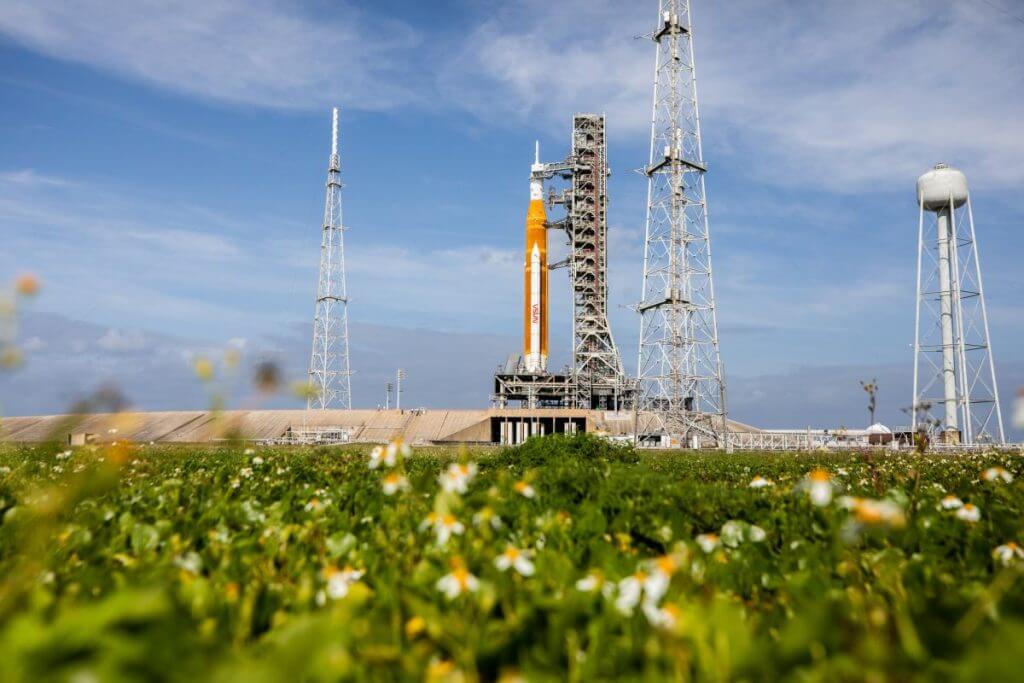
NASA applauds Artemis 1 moon rocket’s fueling milestone, mulls readiness for launch (Image Credit: Space.com)
Monday (June 20) was a big day for NASA’s Artemis 1 mission.
The agency’s huge new moon rocket, the Space Launch System (SLS), wrapped up a more than 50-hour launch simulation known as a “wet dress rehearsal” on Monday evening (June 20). Following several failed attempts in April, mission team members were able to fully fuel SLS for the first time on Monday, wrapping up a series of crucial prelaunch tests.
It was a big milestone for the Artemis 1 moon mission, but there were some snags along the way.
Related: NASA’s Artemis 1 moon mission explained in photos
Ground teams at NASA’s Kennedy Space Center (KSC) in Florida spent the weekend reviewing procedures and checklists for Artemis 1’s SLS, Orion capsule and ground systems the same way they would if they were preparing for an actual launch.
SLS is the backbone of NASA’s Artemis program, a new-age follow-on to Apollo that the space agency hopes will help establish a permanent human presence on the moon. And with a new moonshot comes a new moon rocket. SLS has never flown, and the recent wet dress rehearsal was supposed to be its last hurdle. But whether or not Artemis 1 is actually ready to fly now is not yet clear.
Monday’s activities primarily focused on filling the rocket’s cryogenic fuel tanks. The two-stage SLS uses liquid hydrogen (LH2) and liquid oxygen (LOX) as hypergolic propellants. Three attempts to fuel the rocket during a previous wet-dress try in April were cut short when operators encountered technical issues, including a hydrogen leak high in the Artemis 1 stack’s mobile launch platform (MLP).
Those issues were addressed inside KSC’s Vehicle Assembly Building (VAB) over the past month, but controllers on Monday ran into another hydrogen leak while running the wet dress at the launch pad. This new leak, however, appeared in a “quick disconnect” — a point where the fueling cables connecting the SLS to the MLP are designed to separate during launch.
This new leak affected the proceedings on Monday. Technicians’ efforts to troubleshoot the issue were unsuccessful, and their labors pushed the count back three hours. But, with the SLS fully tanked, NASA officials made the decision to route a software patch enabling them to continue the simulated countdown anyway.
The patch allowed the ground launch sequencer to basically skip over the automatic checks that would have detected the leak, but the onboard flight systems for SLS were unable to undergo the same failsafe bypass. As planned, the terminal count proceeded through the T-33 second mark, at which point the ground computers hand over flight control to SLS’s systems.
The count was ultimately halted at T-29 seconds. NASA had hoped to run the clock all the way down to T-9 seconds, as originally planned, but are deeming the wet dress rehearsal to be largely a success regardless.
Photos: NASA’s new Space Launch System megarocket
“I would say we’re in the 90th percentile,” Mike Sarafin, Artemis mission manager at NASA, said during a call with reporters on Tuesday (June 21).
“Terminal count is a very dynamic time,” explained Charlie Blackwell-Thompson, Artemis launch director with the Exploration Ground Systems Program at KSC.
There are “lots of time-critical events that go on in the terminal count, that are checked both in the flight software and on the ground, and in the interaction between the two,” she added.
Citing the quick-disconnect leak as the only major hiccup during Monday’s tanking, Blackwell-Thompson and other NASA representatives on the call agreed the wet dress was “extremely smooth.”
Now, agency officials have to determine if this wet dress was good enough. The leak prevented the count from reaching the T-9 second target for wet dress launch abort, but that doesn’t mean NASA will have to do the wet dress rehearsal all over again before deciding to launch the Artemis 1 mission, which will send an uncrewed Orion on a roughly month-long journey around the moon. And by Tuesday’s call, nothing had been decided.
“There are a couple of things that we didn’t get in terminal count,” said Blackwell-Thompson. “We’ll go look at what those are. We’ll go look at what that means to us, if there are ways to go test those, and then we’ll come back and make a recommendation.”
“We need to really sit down and … look at what we’ve accomplished, see what additional work might be required, and take a look at the [quick disconnect],” Sarafin added during Tuesday’s call, pointing out that since NASA operators’ long day on Monday, not much work had been done yet to analyze any of the test data.
NASA officials on the call were optimistic about the path ahead, even though they were noncommittal about what’s next for Artemis 1 in the immediate future. On the call, there was a shared confidence that a clearer path forward would emerge in a few days, after the team has had a chance to examine the Artemis 1 stack and data from the wet dress.
“We’ll take all the data from yesterday and roll that into the next time we load this vehicle,” said Blackwell-Thompson. “I’m certain that it’ll be just as smooth as the core stage went yesterday.”
Follow us on Twitter @Spacedotcom (opens in new tab) or on Facebook (opens in new tab).








